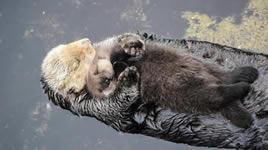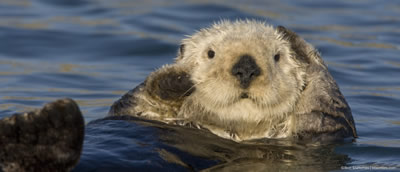Average length: Male: 4-5 feet long Female: 2-3 feet long
Average Weight: Male: 50-100 lbs Female: 30-70 lbs
Average Lifespan: Male: 10-15 years in wild Female: 15-20 years in wild


POPULATION
The Sea Otter is a marine mammal that has 3 subspecies: Southern Sea Otter, Northern Sea Otter, and Russian Sea Otter. The Southern Sea Otter is found in California. The Northern Sea Otter is found in Washington, Canada, and Alaska. The Russian Sea Otter is found off the eastern coast of Russia and several have been reported in Japan. Currently there are less than 3,000 Sea Otters in California, between 65,000 and 78,000 in Washington, Canada, and Alaska combined. And, the Russian population consists of approximately 15,000 with about a dozen in Japan.FUR
Unlike most marine mammals, Sea Otters do not have blubber to protect them from the cold ocean water, but instead have the thickest coat of any animal in the animal kingdom and rely on that fur to keep them warm and from suffering from hypothermia. Sea Otter fur is comprised of two layers, the long outer guard hairs, providing a protective covering and the dense and fine underfur. You may have seen their somersaulting behavior, which is a means to trap air bubbles in their fur, adding the extra insulation they need.

FUN FACTS
Average hairs per square inch on a human head: 700Average hairs per square inch on a sea otter: 170,000 to over 1 million.
THREATS TO SEA OTTERS
It is estimated that the worldwide population of sea otters once numbered between several hundred thousand to over one million before being nearly hunted to extinction by fur traders in the 1700s and 1800s. Sea otters finally gained protections with the signing of the International Fur Seal Treaty of 1911, and became listed under the Marine Mammal Protection and Endangered Species Acts in the 1970s. Worldwide, numbers have slowly recovered but still stand far below original population numbers. While sea otters are vulnerable to natural predators, their populations are significantly impacted by several human factors as well.OIL SPILLS
Oil spills from offshore drilling or shipping are an immense threat to sea otter populations. When sea otters come into contact with oil, it causes their fur to mat, which prevents it from insulating their bodies. Without this natural protection from the frigid water, sea otters can quickly die from hypothermia. The toxicity of oil can also be harmful to sea otters, causing liver and kidney failure as well as severe damage to their lungs and eyes.SHARK ATTACKS
The sea otter habitat range is expanding because of the lack of food in their current range. Unforunately, at the edge of their range, shark-bitten sea otters now account for more than half of the dead animals found. This now exceeds all other causes of mortality combined, and in the last few years, is actually driving a decline in the northern and southern parts of the population. Researchers are not sure why this is happening because there is no record of sea otters ever being food for sharks.CONFLICT WITH HUMANS
Direct conflict with humans, such as shootings and entrapment in fishing traps and nets pose a major threat to sea otter populations. Since sea otters eat many of the same shellfish humans like to eat, such as sea urchins, lobster and crab, they often find themselves in the same areas fishermen like to harvest. Some shell fishers view sea otters as competition and a threat to their economic gain. Many fishermen use fishing gear that can entangle sea otters and cause them to drown.HABITAT DEGRADATION
Pollution on land runs off into the ocean, contaminating the sea otters’ habitat. This can jeopardize their food sources, as well as harm them directly. Sea otters are often contaminated with toxic pollutants and disease-causing parasites as a result of runoff in coastal waters. In California, parasites and infectious disease cause more than 40% of sea otter deaths. Hundreds of sea otters have succumbed to the parasites Toxoplasma gondii and Sacrocystis neurona, which are typically bred in cats and opossums. Scientists have also reported the accumulation of man-made chemicals, such as PCBs and PBDEs, at some of the highest levels ever seen in marine mammals.One of the biggest conservation efforts out there involves removing Otters from the locations of oil spills. It can take a long time to clean up their environment though from the dangers. Without the thousands of volunteers that have assisted with such efforts these Otters would have died as well.
CONSERVATION
The Sea Otter was hunted to near extinction in the 19th century. Today the species is protected under the Endangered Species Act & Marine Mammal Protection Act. The Southern Sea Otter & Southwest Stock of Northern Sea Otters in Alaska are both listed as “threatened” under the Endangered Species Act.Crude oil spills kill Sea Otters in two ways. The black substance saturates their fur, eliminating the insulating air that keeps them warm, causing Sea Otters to get too cold. In attempting to restore the air insulation by grooming their fur with their mouths and claws, the Sea Otters ingest copious amounts of oil and die from organ damage.
You can also get involved by becoming a member of Friends of the Sea Otter, donating money towards conservation work, or volunteering your time. To find out more, please visit us at www.seaotters.org